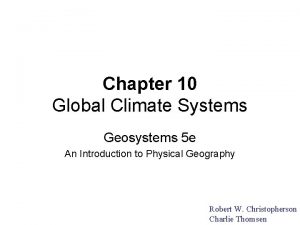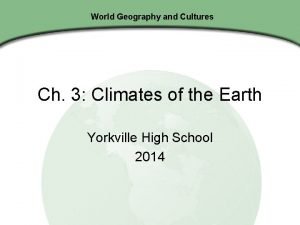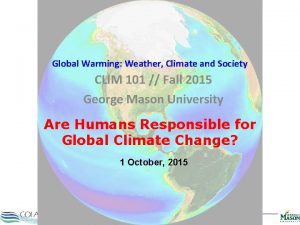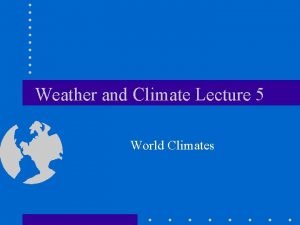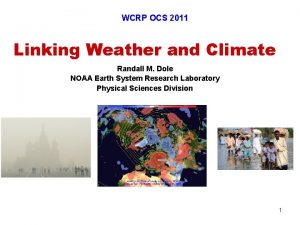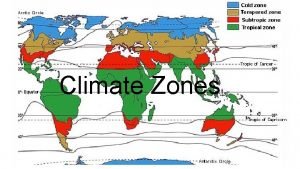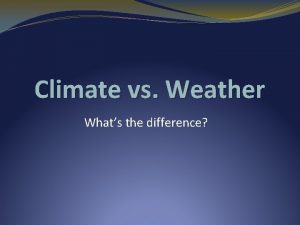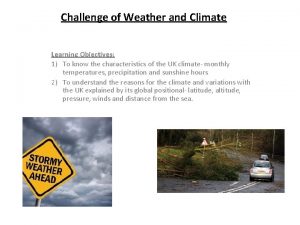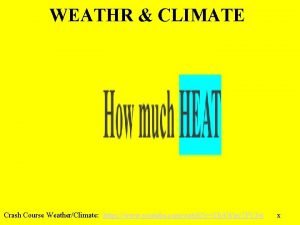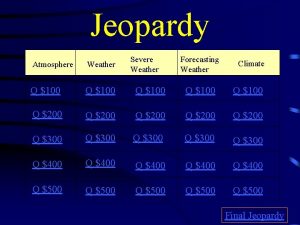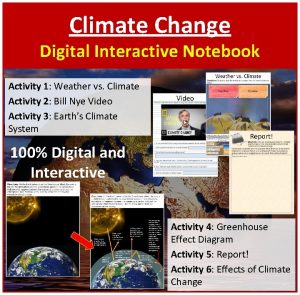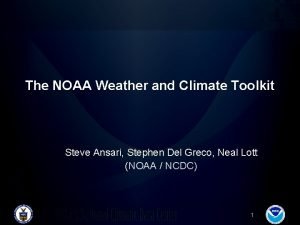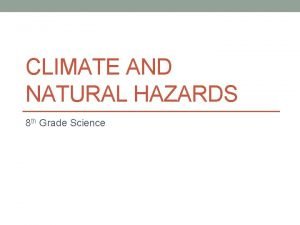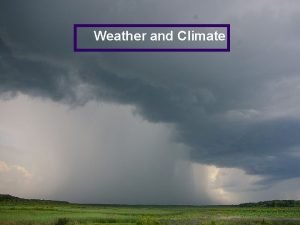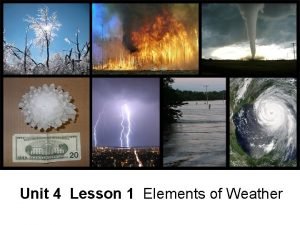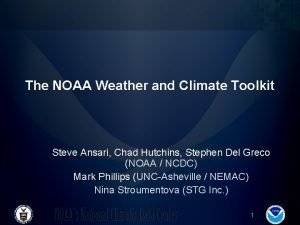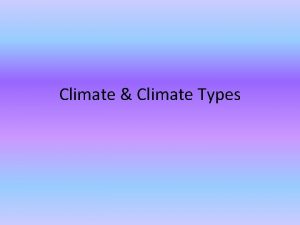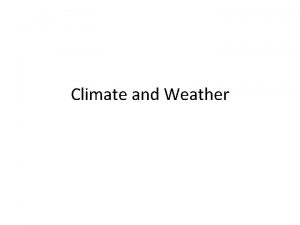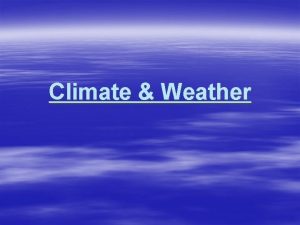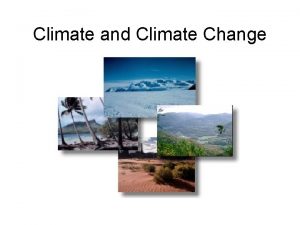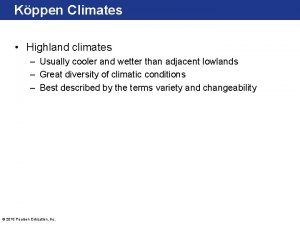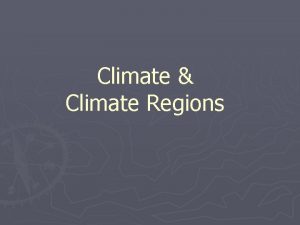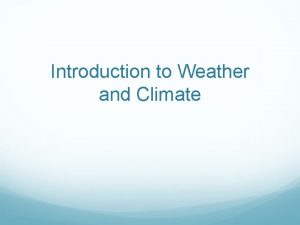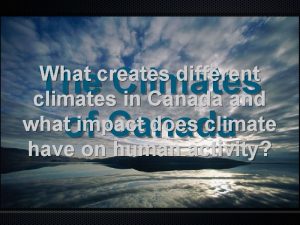Weather and Climate Lecture 5 World Climates Introduction



























- Slides: 27

Weather and Climate Lecture 5 World Climates

Introduction Weather – the atmospheric conditions prevailing at a given time or times in a specific place or area - it is possible to make generalisations about the climate of that place or area - climate : prevailing weather, usually 35 years. - Any area may experience short-term departures from its ‘normal’ climate, but at the same time, it may have long term similarities with the regions in other parts of the world

Major World Climates The different climates of the world can be distinguished by the amount of precipitation, temperature ranges and fluctuations, and can be illustrated by the use of a climograph, which shows the amount of precipitation and the temperatures for the twelve months in a year.

Climographs • Describe the seasonal pattern • rainfall and temperature Temp Rainfall Months

Equatorial Climate • This climate is located in the tropics and principally within the equatorial climate belt 5 deg either side of the Equator. It includes the Amazon and Zaire basins and the coastal lands of Ecuador, West Africa and extreme southeast Asia

Equatorial Climate • Annual temperature range is under 3 deg C inland 1 deg C on the coast • Mean monthly temperatures, range from 26 deg C to 28 deg C • Insolation is evenly distributed throughout the year • Diurnal temperature range is small • Daytime temp rarely rise above 32 deg C due to the presence of afternoon clouds

Equatorial Climate Annual rainfall totals exceed 2000 mm and most afternoons have heavy showers, due to the convergence of the tradewinds at the ITCZ Some areas may have a drier season when the ITCZ moves away from the Equator at the winter and Summer solstices and others have double maxima when the sun is directly overhead the spring and autumn equinoxes.

Tropical Continental Climate This climate is mainly located between latitudes 5 deg and 15 deg N and S of the Equator Temp are high throughout the year - there is a short, slightly cooler season when the sun is overhead at the tropics in the opposite hemisphere

Tropical Continental Climate annual range is also slightly greater due to the sun’s slightly reduced angle in the sky for the part of the year, the greater distance from the sea and the less complete cloud cover and vegetation cover temp may drop slightly at the onset of the rainy season alternating wet/dry seasons wet season occurs when the sun moves overhead bringing with it the heat equator, the ITCZ and the equatorial low pressure belt

Tropical Continental Climate the dry season corresponds with the moving away of the ITCZ leaving the area with the strong, steady tradewinds places near the desert margins: dry, stable conditions (the subtropical high pressure) caused by the migration of the descending limb of the Hadley cell

Desert Climate located in the trade wind belt between 15 deg and 30 deg N or S of the Equator, and on the west coasts of continents where there are cold, offshore, ocean currents

Desert Climate Desert temperatures are characterised by their extremes • annual range is often 20 -30 deg C and the diurnal range is over 50 deg C • daytimes, high temperatures; nigh times, freezing levels • coastal areas however, have much colder monthly temperatures due to the presence of off-shore, cold ocean currents

Mediterranean Climate This type of climate is found on the west coasts of continents between 30 deg and 40 deg N and S of the Equator, ie in Mediterranean Europe. California, central Chile, Cape Province (South Africa) and parts of southern Australia.

Mediterranean Climate This climate is noted for its hot, dry summers and warm, wet winters. Summers in southern Europe are hot Winters are mild partly because the sun’s angle is still quite high but mainly due to the moderating influence of the sea Diurnal temperature ranges are often high due to the fact that many days, even in winter, are cloudless

Mediterranean Climate In winter, the ITCZ and subsequently the subtropical jetstream move southwards allowing the westerlies, which blow from the sea, to bring in moisture orographic and frontal precipitation give high seasonal totals Areas with adjacent, off-shore currents experience advection fogs

Cool temperate continental climate The temperate grassland biome supported by this climate lies in the centre of continents approximately between latitudes 40 deg and 60 deg N of the Equator. The 2 main areas are the North American Prairies and the Russian Steppes.

Cool temperate continental climate The annual range of temperature is high as there is no moderating influence from the sea The land warms up rapidly in summer to give maximum mean monthly readings of around 20 deg C However, the rapid radiation of heat from midcontinental areas in winter means there are several months when the temperature remains below freezing point. The clear skies also result in large diurnal temperature range.

Cool temperate continental climate Annual amounts in both areas only average 500 mm and there is a threat of drought. areas are open to cold blasts of arctic air although the chinook may bring temporary warmer spells to the Prairies

Cool temperate western margins climate Located on the west coasts of continents between approximately 40 deg and 60 deg N and S of the Equator. Apart from north-west Europe, other areas covered in this climate include the northwest of the USA, British Columbia, southern Chile, Tasmania and South Island, New Zealand.

Cool temperate western margins climate Summers are cool, with the warmest month between 15 deg C and 17 deg C Result of the relatively low angle of the sun in the sky, combined with frequent cloud cover and the cooling influence of the sea Winters are mild and mean monthly temperatures remain a few degrees above freezing due to the warming effect of the sea, the presence of warm, offshore, ocean currents and the insulating cloud cover

Cool temperate western margins climate Diurnal temperatures are low; autumns are warmer than springs; and seasonal temperature variations depend on prevailing air masses. This climatic zone lies at the confluence of the Ferrel and Polar cells, where tropical air and polar air converge at the Polar front. The south-westerlies, laden with vapour, give heavy orographic and frontal rain Precipitation often exceeds 2000 mm annually

Cold Cimates The coniferous forest occurs in cold climates to the poleward side of 60 deg N in Eurasia and North America as well as high latitudes in more temperate latitudes and in southern Chile.

Cold Cimates Winters are long and cold, with minimum mean monthly temperatures being as low as negative 30 deg C. no insolation as, at this time of the year, the sun never rises in places north of the Arctic circle Strong winds mean there is a high wind-chill factor; any moisture is rapidly evaporated or frozen. Precipitation is light throughout the year because the air can only hold a limited amount of moisture

Arctic/Tundra Climate The tundra, which lies to the north of the cold climates, includes the extreme northern parts of Alaska, Canada and Russia, together with all of Greenland. The ground, apart from the top few centimetres in Summer, remains permanently frozen (permafrost).

Arctic/Tundra Climate Summers may have lengthy periods of continuous daylight, but with the angle of incidence low temperatures struggle to rise above freezing point and the growing season is exceptionally short Although winters are long, dark and severe, and the sea freezes, the water has a moderating effect on temperatures keeping them slightly higher than inland places further south (Siberia)

Arctic/Tundra Climate • Precipitation, which falls as snow, is light and on average is about 110 mm. It could be classified as a desert if temperatures were warm enough for plant growth

World Climates • What you need to know: • To be able to distinguish one climate type from another from climographs • To be able to account for the temperatures and precipitation received in such climates • Would also be good to know the associated vegetation types with such climates • Africa/Europe as a case study
 Explain how köppen’s climate system classified climates.
Explain how köppen’s climate system classified climates. World geography chapter 3 weather and climate
World geography chapter 3 weather and climate Different climates around the world
Different climates around the world Unit 6 lesson 1 climates of the world
Unit 6 lesson 1 climates of the world World geography chapter 3 climates of the earth
World geography chapter 3 climates of the earth Climate change 2014 mitigation of climate change
Climate change 2014 mitigation of climate change Weather climate and society
Weather climate and society What is this
What is this Cimates
Cimates Conclusion of weather and climate
Conclusion of weather and climate 12 climate zones map
12 climate zones map Whats the difference between weather and climate
Whats the difference between weather and climate Objectives of weather and climate
Objectives of weather and climate Weathr for tomorrow
Weathr for tomorrow Zonas templadas
Zonas templadas What is weather brainpop
What is weather brainpop Weather and climate jeopardy
Weather and climate jeopardy Weather and climate interactive activities
Weather and climate interactive activities Instruments used to measure weather and climate
Instruments used to measure weather and climate Cloud nine idiom
Cloud nine idiom Poem about weather and climate
Poem about weather and climate Noaa weather and climate toolkit
Noaa weather and climate toolkit Explain how some hail can become baseball sized
Explain how some hail can become baseball sized Climatell
Climatell Weather and climate kahoot
Weather and climate kahoot 2 elements of weather
2 elements of weather Noaa climate toolkit
Noaa climate toolkit Weather and climate brainpop
Weather and climate brainpop
